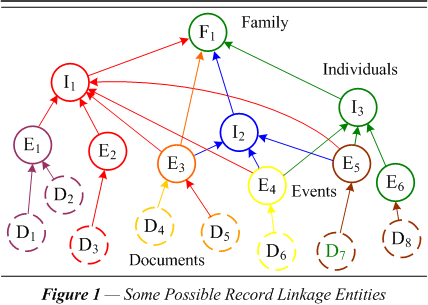
| Event linkage records. Figure 1 relates the three basic kinds of linkage problems as levels in a single process. Event linkage asks whether the two linked document records represent the same event. For example, we may have two records of a person's death, the death certificate (D1) and an obituary (D2). Both records identify the death (E1) of the individual (I1) on a certain date and in a certain place. A third document may record the person's army enlistment (E2). There are a few lines not on the figure that may exist. For example, the death certificate may mention parents or other relatives. Thus D1 may also represent events of a different kind in the lives of other individuals besides I1. For the parents the document implies (or even details) the birth event for their child, for the spouse it implies their marriage event, and for witnesses or unrelated informants, it documents some miscellaneous event in their adult lives. |

| Another example of event linkage is where the marriage records in the Family History Department’s International Genealogical Index (IGI) are duplicated. This index was begun in 1970 to access records of all marriages in the ordinance file. In this case the same event (E3) has two records (D4 and D5) each detailing the event a bit differently. The marriage event involves just two particular individuals (I1 and I2) directly, so that when the event linkage is successful, it is possible to build two records for each of the two individuals and in turn link them. This linkage utilizes the marriage documents in individual linkage. Besides referring to an event in the lives of the two individuals, however, the marriage event refers primarily to the start of a nuclear family. Thus there must be a line in figure 1 from E3 to F1. |
| Locality linkage records. Localities as they are situated in the hierarchy of jurisdictions follow a pattern of a “child-to-parent” or subordinate relationship. It is possible to use the names and other features of identification of each of a locality’s jurisdictional superior to help identify that locality. In record linkage this is called relationship matching. Figure 1 illlustrates how a town as the principal locality is situated in a civil jurisdictional hierarchy. |
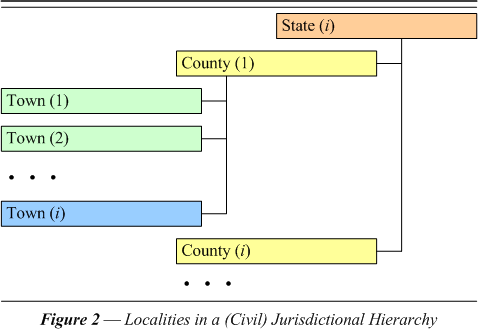
| Thus there are two different kinds of records that may be linked. The locality may be supplied with its own unique identifiers, such as, settlement date, coordinate set of a geographical point representing the town. This linkage is illustrated in the top part of figure 3. In order to perform hierarchical record linkage the attributes of the respective localities of the jurisdictional hierarchies to be matched are compared. The hierarchy may be supplied with identifiers that relate to it. This linkage is shown in the bottom part of figure 3. The comparison illustrated was not a successful match because of the disagreement in the name and other identifiers of the town. |

| Date linkage records. Dates as they are situated in the hierarchy of calendar time periods follow a pattern of a “contained-in” or subordinate relationship. It is possible to use the names and other features of identification of each of a time period’s superior to help identify the date. In record linkage this is called relationship matching. Figure 4 illlustrates how a day as the smallest time period is contained in a month and that in the year. |
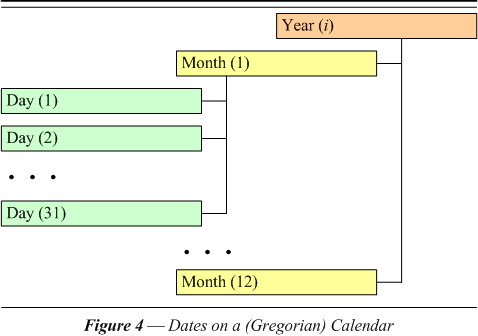
| Thus there are two different kinds of records that may be linked. The date may be interpreted as a unique day in history. The scientific interpretation of a date is called the Julian day number. This number has been assigned by astronomers so as to be unique throughout all time. This linkage is illustrated in the top part of figure 5. |
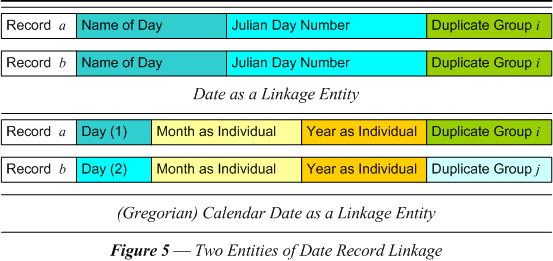
| In order to perform calendrical record linkage the attributes of the respective time periods of the calendar to be matched are compared. The calendar time period may be supplied with identifiers that relate to it. This linkage is illustrated in the bottom part of figure 5. This particular comparison was not a successful match because of the disagreement in the day of the month (digit). |
| Individual linkage records. People as they are situated in the social structure of families follow a pattern of relationships with their kin. It is possible to use the names and other features of identification of each of a person’s relatives to help identify that person. In record linkage this is called relationship matching. |
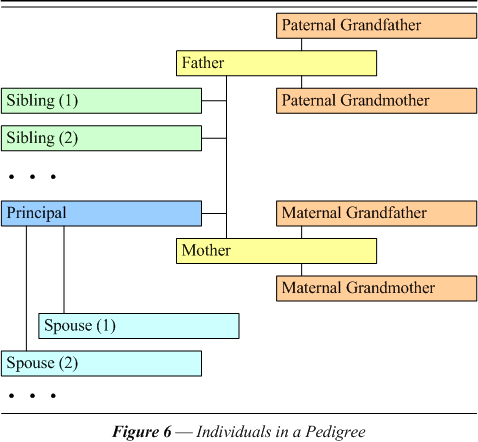
| Individual linkage asks whether the two linkage records represent the same individual. This type of linkage is illustrated at the top of figure 7. |
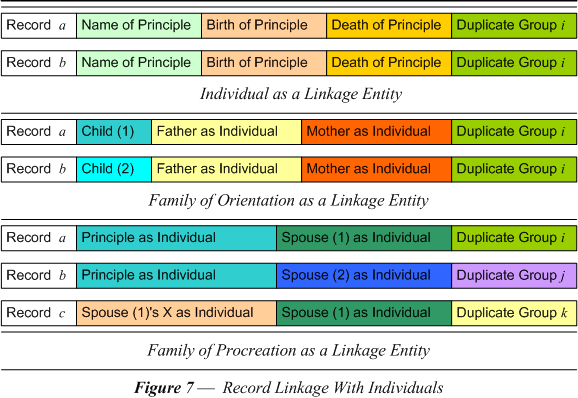
| In this case the identifying events in the records might well be different, though the name and possibly some other such information would have to be the same or compatible. Hence, in figure 1, I1 is identified by name, etc., in the records documenting four different events. When we link individual records in the IGI, one of them (D6) may record the individual’s birth (E4) information while another (D7) the christening (E5) information. It is the similarity in name and proximity in dates and places of the events, i.e., their compatibility that allows linkage. The bottom two parts of figure 7 illustrate the individual portions of two kinds of families. In each case the member individuals stand in certain relationships to other individuals in the family. The linkage of families cannot rely solely on the individuals, but requires that other identifiers, such as marriage and/or divorce events, be brought to bear on the linkage decision. |
| Family linkage records. Family linkage, which asks whether the records represent the same family (F1 in figure 1) has a number of individuals represented, like husband (I1), wife (I2), and children (e.g., I3) belonging in one nuclear family. A good example of this kind of linkage regularly occurs among families represented on Family Group Records. The Library of the Family & Church History Department of the Church of Jesus Christ of Latter-day Saints houses a vast collection of such “group sheets” called the Family Group Records Archives (FGRA). This collection, established in 1942 and supplanted by a very different system in 1970, represented results of research on families submitted for Church temple work done during that period of time. The FGRA system was an attempt to avoid duplication by establishing standards of individual and family identification. To do so researchers brought data for several individuals together on one record of their common nuclear family, each individual filling a different slot on the group sheet. This was to fix the identification of these individuals. They typically also included names referring to the same individuals in different slots on other family group sheets. There are slots for the siblings’ spouses, the parents’ other spouses, and the parent’s own parents’ names. Thus one individual might often be entered on other group sheets depending on that individual’s role in the families represented. |
| Name linkage records. The documents relating to a family genealogy may have many instances of the same family name, and multiple instances of individuals’ given names. Furthermore, the places referred to in the documents may also have various instances of the same place name. By collecting many family genealogies it becomes possible to make some generalizations about the spelling of certain names. The family name could be attested in many different forms and its spelling could have suffered many corruptions by clerks and modern interpreters of the records. The same could be said of the given names of an individual and place names of the localities being referred to. In this case, however, the forms may cluster around certain ones customary for each individual person and place. The name may easily serve as a candidate for a record linkage entity insofar as many spellings may be used to represent the same name. The additional challenge is 1) the collection of a sufficient number of variants for the name, and 2) identifying them in records using appropiate distinctive values. |